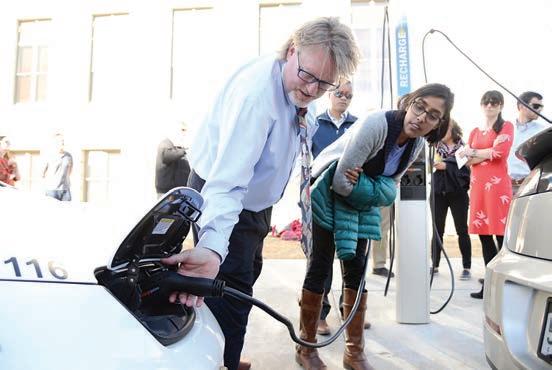
2 minute read
Plan leads to fight over electric vehicle chargers
BY JUDITH KOHLER THE DENVER POST
Supporters of speeding up the move to electric vehicles see investment by utilities as essential, but business groups say it will be hard for them to compete with utilities on providing charging stations for the public.
In its second plan on electric vehicles led with regulators, Xcel Energy proposes spending $145 million to build a public charging network over the next three years in addition to o ering rebates and other programs. Charge Ahead Partnership, a national coalition that includes retailers that want to build EV charging stations, opposes proposals by Xcel and other utilities to install and operate chargers.
Coalition spokesman Ryan McKinnon said regulated utilities like Xcel Energy would have an unfair advantage in the emerging market because they can use ratepayers’ money to invest in the infrastructure and they get a certain rate of return on their investments.
“We’re advocating for poli- cies that will make it more of a level playing eld for private business retailers, basically just letting the free market come in and be able to provide this service without having to compete with a monopoly,” McKinnon said. e coalition also objects to utilities owning and operating chargers because the money will come from ratepayers, including low-income customers and people who don’t have EVs.

Will Toor, executive director of the Colorado Energy O ce, said there’s plenty of room for investors who want to build the thousands of charging stations that will be needed to meet the state’s goals for electrifying transportation.
Scott Bauman, o -street operations manager of City and County of Denver plugs the charger to the electric vehicle.
City of Denver dedicated its first public on-street EV charging station at the corner of 14th Ave and Bannock St. on December 20, 2017.
“I’m more concerned that between state, federal, utility and private sector investment, can we get enough investment to meet that need,” Toor said.

An updated EV plan released earlier this year by the Polis administration calls for 2.1 million cars and SUVs on Colorado roads by 2035 and 1,700 fast chargers and 5,800 slower public chargers.
An analysis by the Inter- national Council on Clean Transportation said that nearly $1 billion will have to be spent on charging infrastructure through this decade if Colorado wants to meet its goals. e analysis suggested that Colorado will need nearly 5,000 fast-charging EV ports by the end of 2030, said Christian Williss, managing director for transportation at the energy o ce.
“Right now we’re at a little over 800,” Williss said. “It kind of takes an all-handson-deck approach.”
Public utilities are regulated but essentially operate as monopolies, providing service in certain geographical areas. In return, they get to recover the costs of building power plants, transmission lines and other expenses while making a certain amount of pro t.
Both Xcel Energy and Black Hills Energy have submitted plans to the PUC for supporting the use of electric vehicles. Business and trade groups that object to utilities getting into the EV charging business have focused on Xcel Energy, is Denver Post story via e Associated Press’ Storyshare, of which Colorado Community Media is a member.
Colorado’s largest electric utility.
Xcel has proposed building and operating up to 460 public fast chargers in its service territory from 20242026. at number is less than 10% of the more than 6,000 additional chargers needed to support the state’s goal of having 940,000 EVs on the road by 2030, Jack Ihle, Xcel’s regional vice president for regulatory policy, said in testimony to the PUC.
“Transportation is the largest source of carbon emissions in the United States and our EV vision complements our net-zero carbon emissions goal for 2050,” Xcel spokeswoman Michelle Aguayo said in an email. e goal is to provide everyone in communities served by Xcel “the bene ts of electric transportation, whether they own an EV, use public transit or bene t from improved air quality,” Aguayo added.









